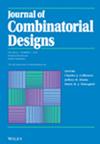E(s 2)$\中的最大列数,E({s}^{2})$—具有16行且s最大=4的最优过饱和设计${s}_{{\rm}}=4$等于60
IF 0.8
4区 数学
Q3 MATHEMATICS
引用次数: 0
摘要
我们证明了E(s2)$\中的最大列数,E({s}^{2})$-具有16行和s最大值=4的最优过饱和设计(SSD)${s}_{{\rm{\max}}}=4$是60, 8. 35)设计成使得来自不同平行类的任意两个块相交于3、5或4个点。这是通过使用并行类交集模式方法来减少搜索空间的穷举计算机搜索来实现的。我们还对所有非同构E(s2)$\,E({s}^{2})$最优5循环SSD,16行,s最大值=8${s}_{{\rm{\max}}=8$。本文章由计算机程序翻译,如有差异,请以英文原文为准。
The maximum number of columns in
E
(
s
2
)
$\,E({s}^{2})$
-optimal supersaturated designs with 16 rows and
s
max
=
4
${s}_{{\rm{\max }}}=4$
is 60
We show that the maximum number of columns in -optimal supersaturated designs (SSDs) with 16 rows and is 60 by showing that there exists no resolvable 2-(16, 8, 35) design such that any two blocks from different parallel classes intersect in 3, 5, or 4 points. This is accomplished by an exhaustive computer search that uses the parallel class intersection pattern method to reduce the search space. We also classify all nonisomorphic -optimal 5-circulant SSDs with 16 rows and .
求助全文
通过发布文献求助,成功后即可免费获取论文全文。
去求助
来源期刊
CiteScore
1.60
自引率
14.30%
发文量
55
审稿时长
>12 weeks
期刊介绍:
The Journal of Combinatorial Designs is an international journal devoted to the timely publication of the most influential papers in the area of combinatorial design theory. All topics in design theory, and in which design theory has important applications, are covered, including:
block designs, t-designs, pairwise balanced designs and group divisible designs
Latin squares, quasigroups, and related algebras
computational methods in design theory
construction methods
applications in computer science, experimental design theory, and coding theory
graph decompositions, factorizations, and design-theoretic techniques in graph theory and extremal combinatorics
finite geometry and its relation with design theory.
algebraic aspects of design theory.
Researchers and scientists can depend on the Journal of Combinatorial Designs for the most recent developments in this rapidly growing field, and to provide a forum for both theoretical research and applications. All papers appearing in the Journal of Combinatorial Designs are carefully peer refereed.

 求助内容:
求助内容: 应助结果提醒方式:
应助结果提醒方式:


